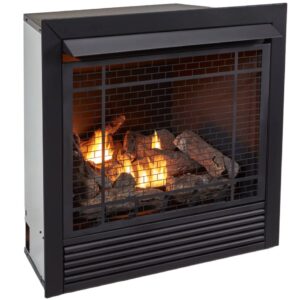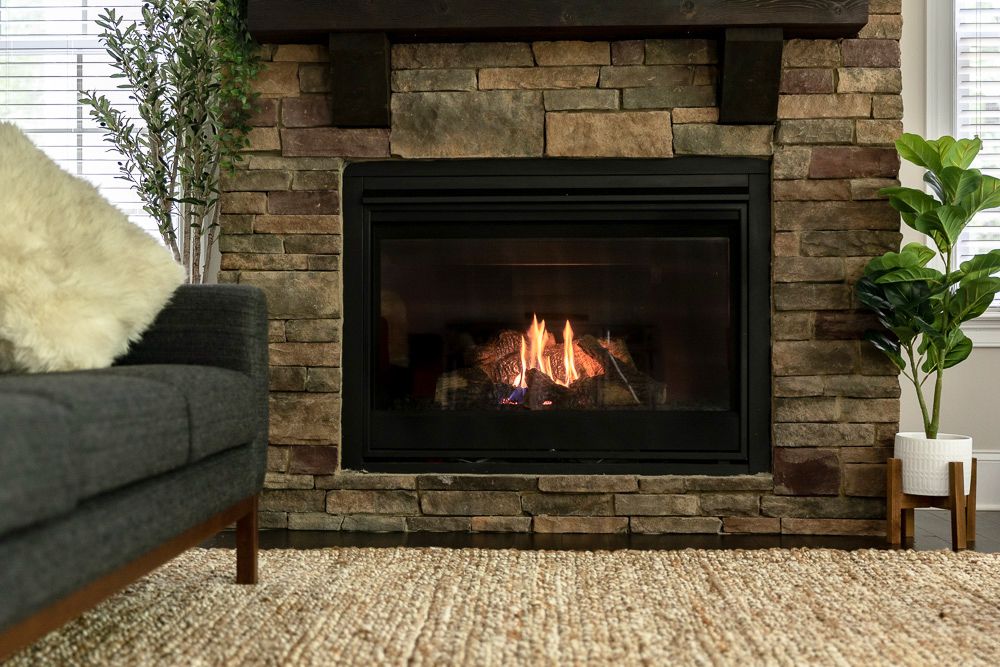Ah, the coziness of a warm and inviting home during the colder months – that’s what we all crave! And when it comes to keeping our homes snug, gas fireplace inserts and furnaces are two popular choices.
Gas fireplace inserts and furnaces differ in several aspects. Gas furnaces are generally more efficient than gas fireplace inserts, with high-efficiency furnaces offering 90% or more AFUE, while gas fireplace inserts burn their fuel at around 70% fuel efficiency. Gas fireplace inserts can be expensive to install, while gas furnaces can be more expensive upfront. Both require regular maintenance to ensure they are running efficiently and safely.
Contents
Understanding Gas Fireplace Inserts
Gas fireplace inserts have their perks! Not only do they deliver targeted heating for specific rooms, but they also add a touch of elegance and ambiance to any space. Plus, they are a more energy-efficient option compared to the traditional, energy-draining wood fireplaces.
No more chopping firewood or dealing with smoke; gas fireplace inserts give you all the warmth and charm with none of the hassle.
However, there’s a caveat – gas fireplace inserts may not be the best primary heating source for larger spaces, as they have a limited heating range and provide localized warmth.
The Functionality of Furnaces
Gas furnaces work by burning natural gas to heat air, which is then efficiently distributed through ductwork and vents to all parts of your home. They are the go-to choice for central heating, offering convenience and comfort with the simple control of a thermostat.
You can easily set the desired temperature and let the furnace do its magic, keeping your entire home toasty and comfortable.
The advantages of gas furnaces lie in their ability to heat larger spaces and provide consistent warmth throughout the entire house. They also come with zoning options, which means you can regulate the temperature in different areas, ensuring personalized comfort for every family member.
On the flip side, gas furnaces consume more energy, especially during the colder months when they are working hard to maintain the perfect indoor temperature.
Comparing Energy Consumption
Now, let’s get down to the nitty-gritty – how much gas do these heating wonders consume? To gauge gas usage, we need to understand the units, such as BTUs, therms, or cubic feet, used to measure gas consumption.
Consequently, gas furnaces tend to use more gas compared to gas fireplace inserts, especially when they serve as the primary heating source for the entire home.
For gas fireplace inserts, the gas consumption primarily depends on the insert’s BTU rating and how frequently and for how long you use it.
These inserts are often used for supplemental heating, providing that extra warmth and ambiance on those chilly nights. As a result, their gas consumption is generally lower compared to furnaces.
Gas furnaces, on the other hand, have a higher BTU rating because they need to heat a more extensive area. The gas consumption of a furnace is influenced by factors such as home size, insulation, thermostat settings, and usage patterns during colder months.
Energy Efficiency: Gas Fireplace Insert vs. Furnace
When it comes to energy efficiency, gas fireplace inserts have a trick up their sleeve! These inserts are designed to be more energy-efficient than traditional wood-burning fireplaces, as they use sealed combustion and direct venting systems, minimizing energy loss.
They provide a controlled and consistent heat output, making them a smart choice for homeowners seeking to reduce their carbon footprint.

Gas furnaces, too, boast relatively high energy efficiency, especially modern models that meet strict energy efficiency standards. However, due to their whole-house heating nature, they consume more gas compared to gas fireplace inserts.
When it comes to the impact on energy bills and long-term savings, it’s essential to weigh the pros and cons. Gas fireplace inserts might save on energy costs if used primarily for targeted heating, while gas furnaces provide comfort for the entire home at the expense of higher gas consumption.
Which Option Is Right for You?
If you wish to add a touch of elegance and warmth to specific rooms, a gas fireplace insert might be your ideal choice. They work wonders as supplemental heating sources, perfect for creating a cozy atmosphere during gatherings or movie nights.
On the other hand, if whole-house comfort and convenience top your list, a gas furnace is likely the better option. A furnace is designed to keep your entire home warm and snug, and with zoning options, you can customize the temperature to suit different areas of your house.
In some scenarios, you don’t have to choose between the two – you can have the best of both worlds! By combining a gas fireplace insert for targeted heating and a gas furnace for whole-house comfort, you can strike the perfect balance between efficiency and coziness.
Maintenance and Safety Considerations
Whichever option you decide, regular maintenance is vital to ensure optimal performance and safety. Gas fireplace inserts should be inspected annually for gas leaks, clean vents, and proper ignition.
Gas furnaces, being central heating systems, necessitate regular filter changes, duct cleaning, and professional servicing to guarantee safe and efficient operation.
Safety should always be a priority when dealing with gas appliances. Regular maintenance and adherence to safety precautions will not only enhance energy efficiency but also ensure the longevity and reliability of the heating systems.
Frequently Asked Questions
Are gas furnaces safe to use?
Yes, gas furnaces are safe to use when properly installed and maintained. However, it is crucial to have them inspected regularly by a qualified technician to check for gas leaks, ensure proper ventilation, and address any potential safety concerns.
How do I decide between a gas fireplace insert and a furnace?
The choice depends on your heating needs and priorities. If you want to add ambiance and warmth to specific rooms, a gas fireplace insert may be ideal. If whole-house comfort and convenience are essential, a gas furnace is likely the better option. You can also consider combining both options for optimal efficiency.
How often should I have my gas fireplace insert or furnace serviced?
Gas fireplace inserts should be inspected annually by a professional technician. Gas furnaces, being central heating systems, should also undergo annual maintenance, including filter changes, duct cleaning, and thorough servicing.
Are there different types of gas fireplace inserts available?
Yes, gas fireplace inserts come in various types, such as direct vent, ventless, and B-vent options. Each type offers unique features and benefits, so it’s essential to choose one that suits your heating needs and installation requirements.
Conclusion
There you have it – a comprehensive comparison of gas fireplace inserts and furnaces! Both options have their unique benefits and applications, and the right choice depends on your heating needs, preferences, and home setup.
If you’re looking for targeted warmth and an elegant ambiance, a gas fireplace insert may be the perfect fit for you. On the other hand, if your heart is set on whole-house comfort and convenience, a gas furnace is your best bet.

